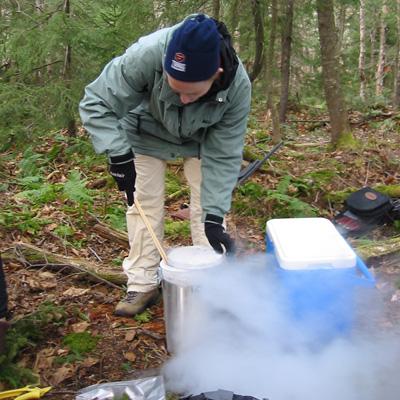Understanding the Influence of Calcium Depletion on Tree Health and Recovery from Stress

Acid deposition depletes critical nutrients from forest soils, which leads to insufficient nutrient uptake by forest plants and predisposes them to decline. Recent work shows red spruce is particularly vulnerable to nutrient deficiency – most notably calcium deficiency. Limited calcium availability increases the likelihood for freeze-induced mortality of foliage, or winter injury. NSRC researchers demonstrated calcium’s involvement in winter injury in two watersheds at the Hubbard Brook Experimental Forest in New Hampshire: one watershed with well-documented depletion of soil calcium due to acid rain, and one watershed with calcium added to replace lost calcium.
Researchers found that in 2003, red spruce on the calcium-depleted watershed lost about 75% of their current-year foliage to winter injury, which is about three times greater than for spruces on the calcium-addition watershed. To better understand these differences, researchers evaluated the health of red spruce trees in these same watershed treatments in the fall and winter of 2005-2006. They found that foliage from trees growing on calcium-fertilized soils stored greater amounts of carbohydrates, exhibited greater antioxidant activity, and were dramatically more cold tolerant than foliage from trees growing on calcium-depleted soils.
These differences in physiology and injury consistent with calcium treatment are important to the health and productivity of red spruce forests. Continued acid-induced soil and foliar calcium depletion would be expected to drive more red spruce forests beyond calcium deficiency thresholds and increase the likelihood of winter injury, crown deterioration, reduced growth, and increased mortality – changes that could alter an entire ecosystem, from seed production and wildlife habitat to carbon sequestration and nutrient cycling.
